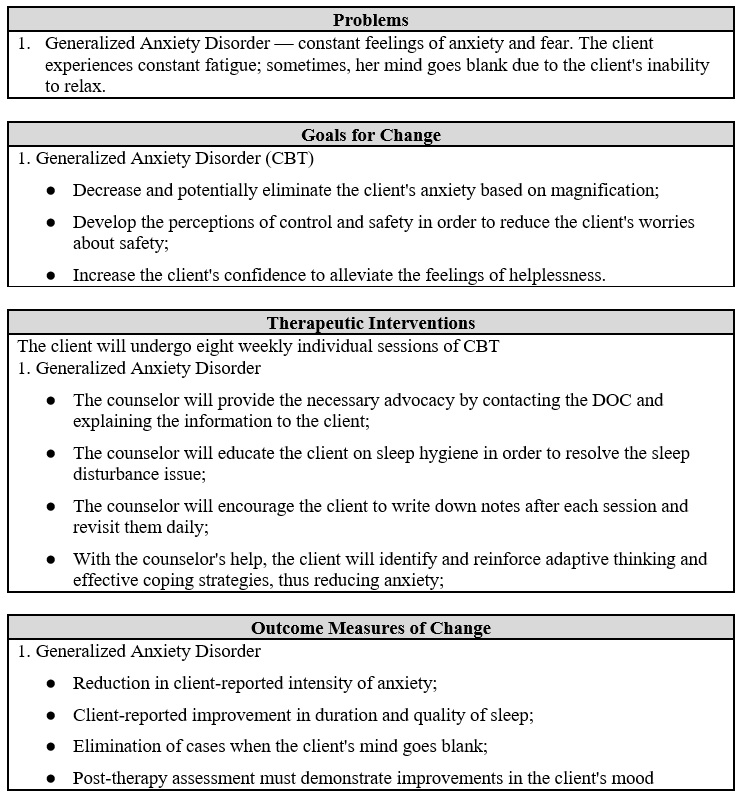Assessment and Diagnosis
Identifying Data
- Date of initial assessment: N/A
- PSEUDO Name: Ana
Reason for Referral/Presenting Problem
Ana is a self-referred and re-occurring client who entered counseling after the case of domestic violence. Ana decided to seek mental health help for the first time after the assault case when an abusive partner broke into her home and threatened her with a knife. Recently, the Department of Corrections (DOC) informed Ana that her ex-partner would be released on probation. As a result, Ana expressed feelings of anxiety and fear for her and her daughter’s safety. During the counseling session, I assured Ana of confidentiality, and she allowed me to document her case for this presentation under a pseudo-name.
Source of Information. The information was obtained during the psychospiritual assessment of the client.
Summary
Ana is a 40-years old Spanish Speaking Latino female; the information on her previous education and profession was unavailable. She did not experience mental health problems until the domestic violence incident. Ana appeared very anxious due to the traumatizing effect of armed assault and worrying news about her ex-partner’s upcoming release. She has a daughter who recently arrived in the United States from Ecuador. Ana said concerns about her own and her daughter’s safety caused problems with sleeping and severe fatigue — sometimes, her mind went blank. From the spiritual perspective, Ana called herself a devout Christian believer and said that religion is one of the few things that offer her comfort in these difficult days full of fear and anxiety.
DSM-5 Diagnosis
- F 41.1 — Generalized Anxiety Disorder (provisional) (American Psychiatric Association [APA], 2013).
- Differential diagnosis: Posttraumatic stress disorder.
Rationale
Judging from the initial assessment, Ana is experiencing the symptoms of generalized anxiety disorder. In particular, she complained about persistent anxiety, worries, and sleep disturbance. In addition, Ana talked about severe difficulties with concentrating and a constant feeling of fatigue. Lastly, Ana mentioned several episodes of her mind going blank. A differential diagnosis of posttraumatic stress disorder may also be applicable since Ana’s anxiety was primarily based on the DOC’s letter containing information about the upcoming release of her abusive ex-partner.
Case Conceptualization
Step 1: Identify and List Client Concerns and Any Other Problem Areas
- Anxiety: Worries about daughter
- Fatigue: Worries about own safety
- Mind going blank; Sleep disturbances
Step 2: Organize Concerns Into Logical Thematic Groupings Descriptive-Diagnostic
Generalized Anxiety Disorder (Descriptive-Diagnostic)
Step 3: Theoretical Inferences: Attach Thematic Groupings to Inferred Areas of Difficulty
- Maladaptive thinking (CBT)
- Ana experienced anxiety related to the following areas: her safety and her daughter’s safety.
- Maladaptive behaviors (CBT)
- Excessive worrying leading to sleep disturbances and subsequent symptoms, such
Step 4: Narrowed Inferences and Deeper Difficulties
Cognitive Distortions: Magnification and Helplessness
Cbt: I Fear for Myself and My Daughter; I Cannot Sleep, I Cannot Relax and Think About Anything Else.
Narrative of the Case Conceptualization
From the cognitive-behavioral therapy (CBT) perspective, Ana has expressed several maladaptive thoughts and behaviors. In particular, her anxiety stemming from excessive worries about the DOC’s decision resulted in sleep disturbance. Ana has become fatigued and restless due to her constant maladaptive thinking. She also developed a cognitive distortion of magnification since she saw her ex-partner’s imminent release as an unavoidable, unmanageable threat. A magnified perception of threat and helplessness triggered crippling anxiety. In turn, anxiety resulted in Ana’s inability to shift focus and evaluate her situation without a lens of fear.
Treatment Planning/Integration/Counseling Theory

Integration of Faith
I apply the Christian faith to counseling via the Integration View, an approach proposed by Stanton Jones. According to Jones (2010), the integration of Christianity and psychology implies providing the notion of the lordship of Christ and God’s true Word with an appropriate place of authority in determining fundamental beliefs. In Ana’s case, I integrated Christianity into counseling in order to boost the client’s confidence and her inner belief in her ability to overcome fear and anxiety. As Isaiah 41:10 says:
- So do not fear, for I am with you;
- do not be dismayed, for I am your God.
- I will strengthen you and help you;
- I will uphold you with my righteous right hand (Holy Bible, New International Version, 1973/2011);
The integration of faith had a positive impact on Ana. As a fellow Christian, she found my approach relatable and supported the idea of drawing mental strength and comfort in faith. In particular, she agreed that God would like to see her strong, not dismayed by the DOC’s decision. Ana said that with God’s help, she would be able to proceed through the therapy and cooperate with the DOC’s victim service unit. From the Christian perspective, Ana’s issues stemmed from desperation and fear. As such, we agreed that prayers and meditation would make a fine addition to the standard CBT interventions and cooperation with the DOC.
Personal Model of Counseling
I am convinced that effective counseling should be based on a scholarly foundation and include a spiritual element. My counseling model includes two elements — CBT as a theoretical basis and Christianity as a potent provider of moral strength for my clients and me. On the one hand, CBT-based interventions are well-suited for identifying and correcting harmful behaviors with a decent degree of effectiveness. On the other hand, Christianity grants me the inner power and wisdom to provide clients with spiritual guidance and moral support. Therefore, I intend to acquire a deeper knowledge of CBT and study the Christian texts to improve my mastery of the personal counseling model.
References
American Psychiatric Association. (2013). Diagnostic and statistical manual of mental disorders (5th ed.). Author.
Holy Bible, New International Version. (2011). Biblica (Original version published 1973).
Jones, S. L. (2010). An integration view. In E. L. Johnson (Ed.), Psychology and Christianity: Five views (2nd ed., pp.101-142). IVP Academic.